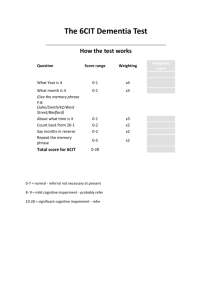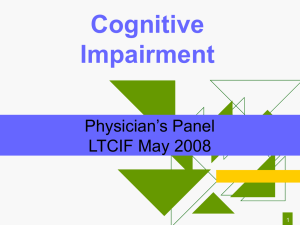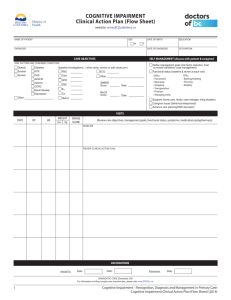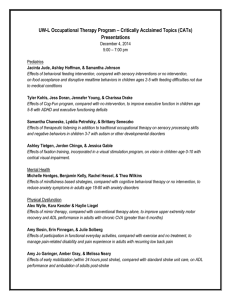Long-Term Care Services and Insurance partment of Health and Human Services,
advertisement
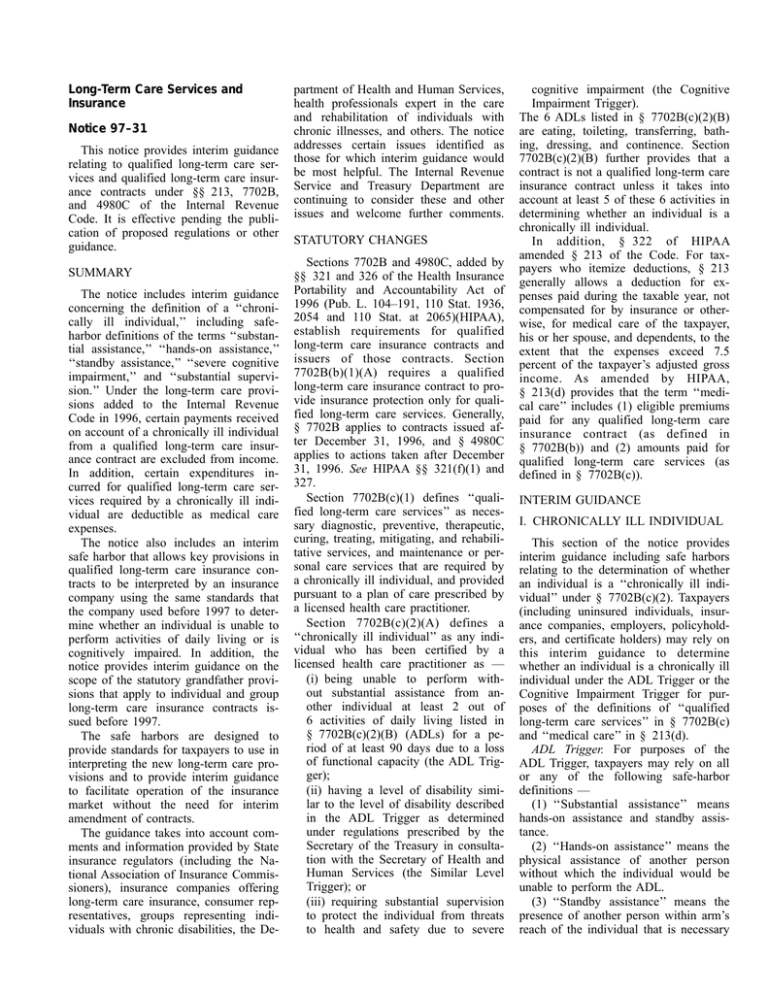
Long-Term Care Services and Insurance Notice 97–31 This notice provides interim guidance relating to qualified long-term care services and qualified long-term care insurance contracts under §§ 213, 7702B, and 4980C of the Internal Revenue Code. It is effective pending the publication of proposed regulations or other guidance. SUMMARY The notice includes interim guidance concerning the definition of a ‘‘chronically ill individual,’’ including safeharbor definitions of the terms ‘‘substantial assistance,’’ ‘‘hands-on assistance,’’ ‘‘standby assistance,’’ ‘‘severe cognitive impairment,’’ and ‘‘substantial supervision.’’ Under the long-term care provisions added to the Internal Revenue Code in 1996, certain payments received on account of a chronically ill individual from a qualified long-term care insurance contract are excluded from income. In addition, certain expenditures incurred for qualified long-term care services required by a chronically ill individual are deductible as medical care expenses. The notice also includes an interim safe harbor that allows key provisions in qualified long-term care insurance contracts to be interpreted by an insurance company using the same standards that the company used before 1997 to determine whether an individual is unable to perform activities of daily living or is cognitively impaired. In addition, the notice provides interim guidance on the scope of the statutory grandfather provisions that apply to individual and group long-term care insurance contracts issued before 1997. The safe harbors are designed to provide standards for taxpayers to use in interpreting the new long-term care provisions and to provide interim guidance to facilitate operation of the insurance market without the need for interim amendment of contracts. The guidance takes into account comments and information provided by State insurance regulators (including the National Association of Insurance Commissioners), insurance companies offering long-term care insurance, consumer representatives, groups representing individuals with chronic disabilities, the De- partment of Health and Human Services, health professionals expert in the care and rehabilitation of individuals with chronic illnesses, and others. The notice addresses certain issues identified as those for which interim guidance would be most helpful. The Internal Revenue Service and Treasury Department are continuing to consider these and other issues and welcome further comments. STATUTORY CHANGES Sections 7702B and 4980C, added by §§ 321 and 326 of the Health Insurance Portability and Accountability Act of 1996 (Pub. L. 104–191, 110 Stat. 1936, 2054 and 110 Stat. at 2065)(HIPAA), establish requirements for qualified long-term care insurance contracts and issuers of those contracts. Section 7702B(b)(1)(A) requires a qualified long-term care insurance contract to provide insurance protection only for qualified long-term care services. Generally, § 7702B applies to contracts issued after December 31, 1996, and § 4980C applies to actions taken after December 31, 1996. See HIPAA §§ 321(f)(1) and 327. Section 7702B(c)(1) defines ‘‘qualified long-term care services’’ as necessary diagnostic, preventive, therapeutic, curing, treating, mitigating, and rehabilitative services, and maintenance or personal care services that are required by a chronically ill individual, and provided pursuant to a plan of care prescribed by a licensed health care practitioner. Section 7702B(c)(2)(A) defines a ‘‘chronically ill individual’’ as any individual who has been certified by a licensed health care practitioner as — (i) being unable to perform without substantial assistance from another individual at least 2 out of 6 activities of daily living listed in § 7702B(c)(2)(B) (ADLs) for a period of at least 90 days due to a loss of functional capacity (the ADL Trigger); (ii) having a level of disability similar to the level of disability described in the ADL Trigger as determined under regulations prescribed by the Secretary of the Treasury in consultation with the Secretary of Health and Human Services (the Similar Level Trigger); or (iii) requiring substantial supervision to protect the individual from threats to health and safety due to severe cognitive impairment (the Cognitive Impairment Trigger). The 6 ADLs listed in § 7702B(c)(2)(B) are eating, toileting, transferring, bathing, dressing, and continence. Section 7702B(c)(2)(B) further provides that a contract is not a qualified long-term care insurance contract unless it takes into account at least 5 of these 6 activities in determining whether an individual is a chronically ill individual. In addition, § 322 of HIPAA amended § 213 of the Code. For taxpayers who itemize deductions, § 213 generally allows a deduction for expenses paid during the taxable year, not compensated for by insurance or otherwise, for medical care of the taxpayer, his or her spouse, and dependents, to the extent that the expenses exceed 7.5 percent of the taxpayer’s adjusted gross income. As amended by HIPAA, § 213(d) provides that the term ‘‘medical care’’ includes (1) eligible premiums paid for any qualified long-term care insurance contract (as defined in § 7702B(b)) and (2) amounts paid for qualified long-term care services (as defined in § 7702B(c)). INTERIM GUIDANCE I. CHRONICALLY ILL INDIVIDUAL This section of the notice provides interim guidance including safe harbors relating to the determination of whether an individual is a ‘‘chronically ill individual’’ under § 7702B(c)(2). Taxpayers (including uninsured individuals, insurance companies, employers, policyholders, and certificate holders) may rely on this interim guidance to determine whether an individual is a chronically ill individual under the ADL Trigger or the Cognitive Impairment Trigger for purposes of the definitions of ‘‘qualified long-term care services’’ in § 7702B(c) and ‘‘medical care’’ in § 213(d). ADL Trigger. For purposes of the ADL Trigger, taxpayers may rely on all or any of the following safe-harbor definitions — (1) ‘‘Substantial assistance’’ means hands-on assistance and standby assistance. (2) ‘‘Hands-on assistance’’ means the physical assistance of another person without which the individual would be unable to perform the ADL. (3) ‘‘Standby assistance’’ means the presence of another person within arm’s reach of the individual that is necessary to prevent, by physical intervention, injury to the individual while the individual is performing the ADL (such as being ready to catch the individual if the individual falls while getting into or out of the bathtub or shower as part of bathing, or being ready to remove food from the individual’s throat if the individual chokes while eating). An individual is a chronically ill individual under the ADL Trigger only if a licensed health care practitioner has certified that the individual is unable to perform (without substantial assistance from another individual) at least 2 ADLs for a period of at least 90 days due to a loss of functional capacity. This 90-day requirement does not establish a waiting period before which benefits may be paid or before which services may constitute qualified long-term care services. Cognitive Impairment Trigger. For purposes of the Cognitive Impairment Trigger, taxpayers may rely on either or both of the following safe-harbor definitions— (1) ‘‘Severe cognitive impairment’’ means a loss or deterioration in intellectual capacity that is (a) comparable to (and includes) Alzheimer’s disease and similar forms of irreversible dementia, and (b) measured by clinical evidence and standardized tests that reliably measure impairment in the individual’s (i) short-term or long-term memory, (ii) orientation as to people, places, or time, and (iii) deductive or abstract reasoning. (2) ‘‘Substantial supervision’’ means continual supervision (which may include cuing by verbal prompting, gestures, or other demonstrations) by another person that is necessary to protect the severely cognitively impaired individual from threats to his or her health or safety (such as may result from wandering). Under the Cognitive Impairment Trigger, unlike the ADL Trigger, a qualified long-term care insurance contract is not required to take any ADL into account for purposes of determining whether an individual is a chronically ill individual. Safe-Harbor for Continuation of Pre1997 Insurance Standards. This safe harbor applies to post-1996 long-term care insurance contracts (including any pre-1997 contracts not grandfathered under § 321(f)(2) and the grandfather rules in this notice for certain pre-1997 insurance contracts) issued by an insurance company with outstanding pre1997 long-term care insurance contracts that base eligibility for payments upon the inability to perform any of the ADLs (eating, toileting, transferring, bathing, dressing, and continence) or cognitive impairment. Insurance companies, policyholders, and certificate holders may rely on this safe harbor (as well as the safe-harbor definitions above for the ADL and Cognitive Impairment Triggers) to determine whether an individual is a chronically ill individual under both or either the ADL Trigger and the Cognitive Impairment Trigger for purposes of the definition of a ‘‘qualified long-term care insurance contract,’’ whether or not the post-1996 contracts generally incorporate the provisions of § 7702B(c)(2). In order to rely on any of these safe harbors for federal tax purposes, contracts are not required to incorporate or refer to the safe harbors. In applying the ADL Trigger to its post-1996 contracts, an insurance company is permitted to use the same standards that it uses to determine whether an individual is unable to perform an ADL for purposes of eligibility for benefit payments under its pre-1997 contracts (‘‘pre-1997 ADL standards’’). If the insurance company makes determinations regarding an individual’s inability to perform an ADL under a post-1996 contract using its pre-1997 ADL standards, the contract will be deemed to satisfy the requirement under the ADL Trigger that an individual is unable to perform (without substantial assistance from another person) that ADL due to a loss of functional capacity. For example, if an insurance company has outstanding pre-1997 longterm care insurance contracts that provide for benefit payments if the insured is unable to perform at least 2 ADLs (whether or not the contracts refer to substantial assistance), the company may interpret ‘‘substantial assistance’’ for purposes of the ADL Trigger as requiring the same assistance as the company requires under its pre-1997 contracts. In applying the Cognitive Impairment Trigger to its post-1996 contracts, an insurance company is permitted to use the same standards that it uses to determine whether an individual qualifies for benefits due to cognitive impairment under its pre-1997 contracts (‘‘pre-1997 cognitive impairment standards’’). If the insurance company makes determinations regarding an individual’s cognitive impairment under a post-1996 contract using its pre-1997 cognitive impairment standards, the contract will be deemed to satisfy the requirement under the Cognitive Impairment Trigger that an 6 individual requires substantial supervision to protect the individual from threats to health and safety due to severe cognitive impairment. This safe harbor for continuation of pre-1997 insurance standards applies only for purposes of determining whether an individual (1) is unable to perform (without substantial assistance from another person) an ADL due to a loss of functional capacity or (2) requires substantial supervision to protect the individual from threats to health and safety due to severe cognitive impairment. This safe harbor does not apply for purposes of the other statutory requirements of § 7702B(c)(2), such as (1) the requirement that an individual’s loss of functional capacity apply to at least 2 of 5 or 6 ADLs, (2) the requirement for a certification by a licensed health care practitioner, and (3) the 90-day requirement. These statutory requirements must be satisfied in order for the individual to be a ‘‘chronically ill individual’’ under the ADL or Cognitive Impairment Trigger, whether or not similar requirements are imposed under the insurance company’s pre-1997 contracts. II. QUALIFIED LONG-TERM CARE INSURANCE This section of the notice addresses certain issues relating to the consumer protection provisions of §§ 7702B(b), 7702B(g), and 4980C, rules for adjustments to nonforfeiture benefits under § 7702B(g)(4), and the grandfather rules for certain pre-1997 insurance contracts. Taxpayers (including insurance companies, employers, policyholders, and certificate holders) may rely on this interim guidance for purposes of the definition of ‘‘qualified long-term care insurance contract’’ in § 7702B(b) and the requirements of § 4980C. Consumer Protections Applicable to Long-Term Care Insurance. Under §§ 7702B(b)(1)(F), 7702B(g), and 4980C, qualified long-term care insurance contracts and issuers of those contracts are required to satisfy certain requirements of the Long-Term Care Insurance Model Act (Model Act) and Long-Term Care Insurance Model Regulation (Model Regulation) promulgated by the National Association of Insurance Commissioners (NAIC), as adopted as of January 1993. The requirements for qualified long-term care insurance contracts under §§ 7702B(b)(1)(F) and 7702B(g) relate to guaranteed renewal or noncancellability, prohibitions on limitations and exclusions, extension of benefits, continuation or conversion of coverage, discontinuance and replacement of policies, unintentional lapse, disclosure, prohibitions against postclaims underwriting, minimum standards, inflation protection, prohibitions against preexisting conditions and probationary periods, and prior hospitalization. The requirements for qualified long-term care insurance contracts under § 4980C relate to application forms and replacement coverage, reporting requirements, filing requirements for marketing, standards for marketing, appropriateness of recommended purchase, standard format outline of coverage, delivery of a shopper’s guide, right to return, outline of coverage, certificates under group plans, policy summary, monthly reports on accelerated death benefits, and incontestability period. Sections 7702B and 4980C reference NAIC model provisions that specify exact language (including punctuation), captions, format, and content that must be included in long-term care insurance contracts, applications, outlines of coverage, policy summaries, and notices. See, e.g., §§ 10, 13, and 24 of the Model Regulation. In the case of a State that has adopted all or any portion of the Model Act or Model Regulation, compliance with the applicable requirement of State law is considered compliance with the parallel Model Act or Model Regulation requirement specified in § 7702B(g) or § 4980C, and failure to comply with that requirement of State law is considered failure to comply with the parallel Model Act or Model Regulation requirement in § 7702B(g) or § 4980C. For example, if a particular State has adopted Section 6C of the Model Act (relating to preexisting conditions), then, for a contract that is subject to that State’s insurance laws, compliance with that State law is considered compliance with § 7702B(g)(2)(A)(ii)(I) and failure to comply with that State law is considered failure to comply with § 7702B(g)(2)(A)(ii)(I). In accordance with § 4980C(f), in the case of a State that imposes a requirement that is more stringent than the analogous requirement imposed by § 7702B(g) or § 4980C, compliance with the applicable requirement of State law is considered compliance with the parallel Model Act or Model Regulation requirement in § 7702B(g) or § 4980C. If a State has not adopted a provision of the Model Act or Model Regulation that is specified in § 7702B(g) or § 4980C (and has not adopted a requirement that is more stringent than the requirement imposed by that provision), the language, caption, format, and content requirements imposed by the Model Act or Model Regulation provision with respect to contracts, applications, outlines of coverage, policy summaries, and notices will be considered satisfied for a contract subject to the law of that State if the language, captions, format, and content are substantially identical in all material respects to those required under that Model Act or Model Regulation provision. Adjustments to Nonforfeiture Benefits Under Insurance Contracts. Section 7702B(g)(4)(B)(ii) provides that the amount of a nonforfeiture benefit available in the event of a default in premium payments may be subsequently adjusted only as necessary to reflect changes in claims, persistency, and interest that have been taken into account in a change in the premium rates for contracts issued on the same contract form if the contract form has been approved by the Secretary of the Treasury. Solely for the purpose of making such adjustments, approval by the State insurance commissioner or other applicable State authority will be treated as approval by the Secretary of the Treasury. Grandfather Rules for Certain Pre1997 Insurance Contracts. Section 321(f)(2) of HIPAA provides that a contract issued before January 1, 1997, is treated as a qualified long-term care insurance contract if the contract met the ‘‘long-term care insurance requirements of the State’’ in which the contract was sitused at the time it was issued. For this purpose, the ‘‘long-term care insurance requirements of the State’’ means the State laws (including statutory and administrative law) that are intended to regulate insurance coverage that constitutes ‘‘long-term care insurance’’ (as defined in § 4 of the Long-Term Care Insurance Model Act as adopted by the NAIC in December, 1995), regardless of the terminology used by the State in describing the insurance coverage. For purposes of applying the grandfather rule of § 321(f)(2) to a contract other than a group contract, the issue date of a contract is generally the date assigned to the contract by the insurance company, but in no event earlier than the date the application is signed. How- 7 ever, if the period between the date of application and the date on which the contract is actually placed in force is substantially longer than under the insurance company’s usual business practice, then the issue date is the date the contract is placed in force. For purposes of applying the grandfather rule of § 321(f)(2) to a group contract, the issue date of the contract is the date the group contract was issued. Thus, insurance coverage under certificates evidencing the addition, on or after January 1, 1997, of individuals to the coverage available under a grandfathered group contract is accorded the same grandfather treatment under § 321(f)(2) as the preexisting coverage under the grandfathered group contract. A policyholder’s right to return a long-term care insurance contract within a ‘‘free-look’’ period following delivery (with a refund of any premiums that have been paid) is not taken into account in determining the issue date of the contract. For purposes of applying the grandfather rule of § 321(f)(2), any material change in a contract will be considered the issuance of a new contract. This includes any change in the terms of the contract altering the amount or timing of any item payable by the policyholder (or certificate holder), the insured, or the insurance company. For example, for purposes of § 321(f)(2), any change in the terms of a contract altering the amount or timing of benefits (including nonforfeiture benefits) or premiums constitutes a material change that will be considered the issuance of a new contract. A substitution of the insured under an individual contract, or a change (other than an immaterial change) in the eligibility for membership in the group covered by a group contract, also constitutes a material change that will be considered the issuance of a new contract. However, the unilateral exercise of an option or right granted to a policyholder under the contract as in effect on December 31, 1996, will not constitute a material change. For this purpose, a unilateral exercise includes only a change that becomes effective without any consent or other non-ministerial action by the issuer of the contract. A contract issued in an exchange after December 31, 1996, for an existing contract is considered a contract issued after that date. COMMENTS REQUESTED The Internal Revenue Service and Treasury Department invite comments concerning the application of new §§ 7702B and 4980C, the amendments made to § 213, and other federal income tax provisions relating to longterm care as enacted under HIPAA §§ 321 through 326, including the standards and definitions in this notice. Comments are particularly requested on: (1) whether the relief provided for insurance contracts complying with the interim guidance provided in this notice needs to be extended beyond the effective date of more definitive guidance; and (2) the types of disability that should be included in any regulations that may be prescribed under the Similar Level Trigger. Comments should be submitted by August 4, 1997. Written comments should be sent to: Internal Revenue Service, P.O. Box 7604, Ben Franklin Station, Attn: CC:CORP:T:R, Room 5228, Washington, DC 20044. Alternatively, submissions may be hand delivered between the hours of 8 a.m. and 5 p.m. to: CC:DOM:CORP:R (Notice 97–31), Courier’s Desk, Internal Revenue Service, 1111 Constitution Avenue, NW, Washington, DC. Finally, taxpayers may submit comments electronically via the Internal Revenue Service INTERNET site at: http:// www.irs.ustreas.gov/prod/tax_regs/ comments.html. All submitted comments will be available for public inspection and copying. FURTHER INFORMATION For further information, contact Ms. A. Kathie Jacob Kiss at (202) 622–4920 regarding section I of this notice and Ms. Katherine A. Hossofsky at (202) 622–3970 regarding section II of this notice (not toll-free calls). PROCEDURAL INFORMATION This document serves as an ‘‘administrative pronouncement’’ as that term is defined in § 1.6661–3(b)(2) of the Income Tax Regulations and may be relied upon to the same extent as a revenue ruling or a revenue procedure. (Also Part I, sections 807, 812, 817A) Modified Guaranteed Contracts Notice 97–32 SUMMARY: This notice provides interim rules with regard to the interest rate to be used in the determinations under §§ 807(c)(3), 807(d)(2)(B), and 812 for a ‘‘modified guaranteed contract,’’ as defined in § 817A(d). It also describes the manner in which § 811(d) is to be applied to these contracts. Section 817A was added by § 1612 of the Small Business Job Protection Act of 1996, Pub. L. 104–188, 110 Stat. 1755. Section 817A is effective for taxable years beginning after December 31, 1995. See Small Business Job Protection Act § 1612(c)(1). This notice is effective pending the publication of further guidance. BACKGROUND: Life insurance companies issue modified guaranteed annuity and life insurance contracts. A modified guaranteed contract temporarily guarantees a higher return than the permanently guaranteed crediting rate, in exchange for shifting additional investment risk to the policyholder in the form of a market value adjustment. The temporary guarantee may be a fixed rate or a rate based on bond or equity yields, such as a percentage of an increase in the S&P 500 index. During the temporary guarantee period, the amount paid to the policyholder upon surrender is increased or decreased by the market value adjustment, which is determined by a formula in the modified guaranteed contract. The market value adjustment generally is based on a published bond index. Modified guaranteed contracts can be issued out of a life insurance company’s general account or segregated account. Section 817A provides special tax treatment for certain modified guaranteed contracts issued out of a segregated account. For this purpose, the term ‘‘modified guaranteed contract’’ (‘‘MGC’’) is defined as an annuity, life insurance, or pension plan contract (other than a variable contract described in § 817) under which all or part of the amounts received under the contract are allocated to a segregated account. Assets in this segregated account must be valued from time to time with reference to market values, and reserves must be valued at market for annual statement purposes. Further, an MGC must provide either for a net surrender value or for a policyholder’s fund (as defined in § 807(e)(1)). If only a portion of a contract is not described in § 817, such portion is treated as a separate contract for purposes of applying § 817A. The tax reserves for an MGC are computed under either § 807(c)(3) or 8 § 807(d). Section 807(c)(3) provides that reserves for obligations under insurance and annuity contracts not involving life, accident, or health contingencies are computed using an appropriate rate of interest. The appropriate rate of interest is the highest (as of the time the obligation first did not involve life, accident, or health contingencies) of the following rates: (1) the ‘‘applicable Federal interest rate’’ (as defined in § 807(d)(2)(B)(i)); (2) the ‘‘prevailing State assumed interest rate’’ (as defined in § 807(d)(2)(B)(ii)); or (3) the rate of interest assumed by the insurance company to determine the contract’s guaranteed benefit. Section 807(c) also provides that the reserves computed under § 807(c)(3) are never less than the net surrender value of the contract. 1 For an MGC that gives rise to life insurance reserves, as defined in § 816(b), reserves are computed under § 807(d). Under § 807(d)(1), the life insurance reserves for a contract cannot exceed the statutory reserves (as defined in § 809(b)(4)(B)) for the contract. Subject to that cap, a contract’s life insurance reserves equal the greater of: (1) the contract’s net surrender value; or (2) the contract’s Federally prescribed reserve determined under § 807(d)(2). Section 807(d)(2) provides that the Federally prescribed reserves for a contract are determined using: (1) the tax reserve method applicable to the contract; (2) the greater of the applicable Federal interest rate or the prevailing State assumed interest rate in effect on the date of the issuance of the contract; and (3) the prevailing commissioners’ standard tables for mortality and morbidity. In the case of a life insurance contract covered by the Commissioners’ Reserve Valuation Method (‘‘CRVM’’) or an annuity contract covered by the Commissioners’ Annuities Reserve Valuation Method (‘‘CARVM’’), § 807(d)(3) provides that the tax reserve method applicable to a contract is the CRVM or CARVM prescribed by the National Association of Insurance Commissioners (‘‘NAIC’’), which is in effect on the date of the issuance of the contract. Section 811(d) imposes an additional reserve computation restriction for contracts that guarantee beyond the end of 1 For contracts other than MGCs, § 807(e)(1) provides that net surrender value is determined taking into account any penalty or charge which would be imposed upon surrender but ignoring any market value adjustment. The net surrender values of MGCs, however, take into account market value adjustments. § 817A(a).
